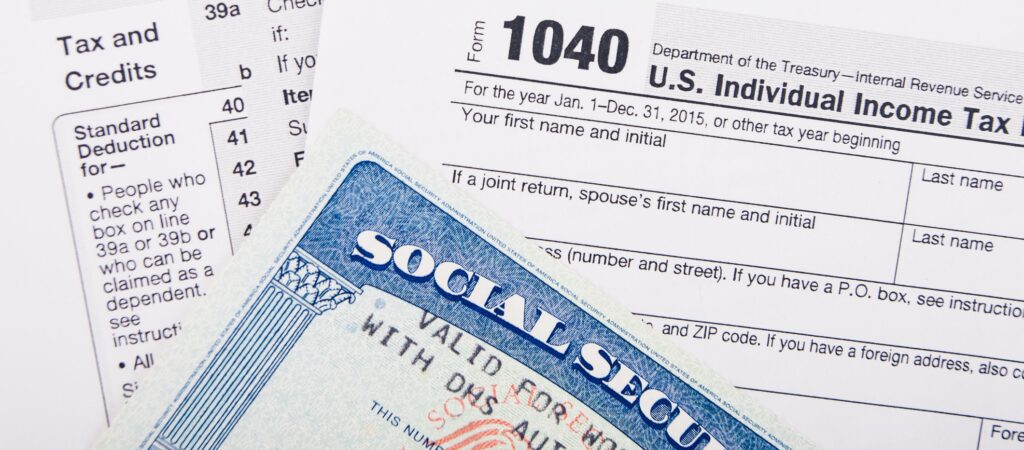One of the more surprising and frustrating elements of federal income taxation is the need for seniors, who have worked their entire lives paying into the Social Security system, to include the payments they receive from the government, once retired, in their taxable incomes. As a result of this requirement, many seniors find themselves with unexpected tax liabilities associated with the receipt of Social Security payments upon retirement.
Making the issue even more complex is the fact that no individual is afforded a federal tax deduction for Social Security taxes when paid. Consider the following example, assuming an individual earns $65,000 in Year 1. Under current rules, the employee’s share of Social Security (including the Medicare portion) is $4,972 (calculated as 7.65% times $65,000). Note that the gross wages, $65,000, is subject to regular income tax in that year. Thus, even though the individual pays into the system in the amount of $4,972, he or she also pays income tax on that amount.
Current estimates indicate that as many as 64 million American taxpayers receive retirement, survivor and disability benefits. Given this large contingent of the taxpayer community, it might be assumed that it is common knowledge that Social Security payments may be taxable. However, few people fully understand why their payments are subject to income tax and exactly how the computations are made.
The reason for this lack of understanding is because this is a rather complex machination. The following information is intended to provide some level of clarity for those that might be interested.
Determining if the benefits are subject to income tax
The taxation of Social Security is not a straightforward affair. As with all tax bills, details intended to aid Congress and the President in accomplishing specific domestic initiatives create a more complex calculation methodology than one would expect. With respect to the taxation of Social Security, it was the intent of the bill to add this tax obligation only to those with incomes over a certain level, thereby making the taxation progressive. As a result, the amounts subject to tax are generally on the income tax returns of wealthier Americans who have paid the most into the system. For those individuals, up to 40% of the Social Security payments received may need to be paid back to the government as regular income tax.
To determine if any Social Security benefits are taxable, taxpayers must add 50% of the Social Security benefits received in a single tax year to their adjusted gross income, plus any nontaxable interest received. The total is what is known as “combined income.” An example may help to add clarification:
Assume a person’s annual Social Security benefits are $20,000, and that he works a part-time job where he earned $12,000 last year. The individual has no other income or interest. Add half the benefits ($10,000) to the part-time income ($12,000) for a combined income of $22,000.
Keep in mind that married couples must calculate their combined income using their joint income and both spouses’ Social Security benefits.
Once the combined income is determined, one needs to compare it to certain base income amounts. The categories represent a taxpayer’s tax filing status.
- $25,000 for single, head of household and qualifying widow(er)s
- $25,000 for individuals married, filing separately and living apart from their spouse for the entire year
- $32,000 for married couples filing jointly
- $0 for individuals married, filing separately but living with their spouse
If the individual’s combined income falls below these base amounts, the Social Security benefits are not subject to the income tax. If, however, the combined income exceeds the respective base amount, the Social Security payments are then taxable. The next step, then, is to determine the amount of tax due.
Calculating the income tax
If combined income exceeds the respective base amount, taxpayers will then pay tax on up to 50-85% of their Social Security benefits.
Again, to make the tax progressive, the amount that any taxpayer may be required to pay depends on where the combined income falls under these guidelines:
- Individual filers will pay tax on up to 50% of their Social Security benefits should their combined income be between $25,000 and $34,000. Those with a combined income greater than $34,000 may pay taxes on up to 85% of their benefits.
- Married filers with joint returns will pay tax on up to 50% of their Social Security benefits should their combined income be between $32,000 and $44,000. Those with a combined income greater than $44,000 may pay taxes on up to 85% of their benefits.
Note that those numbers are “up to” 50% and 85%. The actual percentage any taxpayer might pay depends upon a complex worksheet the Internal Revenue Service provides for taxpayer convenience. There are several calculators on the Internet, including at the official Social Security website.
In addition to federal taxes, it must not be forgotten that there are some states that require inclusion of Social Security in the determination of state income tax due. Fortunately, Pennsylvania is not one of those states. The Retirement Living Information Center has compiled state tax information on their website. From the main page, click on your state and then look for the section on retirement income taxes.
Notes on Supplemental Security Income and benefits received on behalf of children
Finally, questions are often posed with respect to two other key programs/benefits within the overall Social Security system.
The first deals with Supplemental Security Income, otherwise known as SSI. Some individuals receiving Social Security benefits may also receive SSI and may wonder if these payments are taxable. SSI is not taxable income and, thus, is not subject to the income tax calculation.
The second related topic involves Social Security payments issued to parent payees on behalf of their children. Parents wondering if they need to claim this income on their tax return, do not need to be concerned as those benefits are not deemed to part of the parents’ income. Under the tax rules, these benefits are considered to be the child’s income and not the parents’.
Conclusion
Understanding and dealing with the taxation of Social Security is a critical part of both annual tax compliance and long-term retirement planning. Individuals must factor in the tax reduction in net spendable Social Security benefits to ensure that their future sources of cash flow are calculated as accurately as possible.
To read more on the topic, you may go to the Social Security website or the Internal Revenue Service website.
Should you have questions, please contact Bob Grossman or Don Johnston at 412-338-9300.






